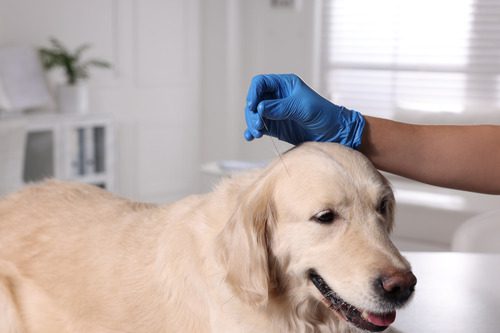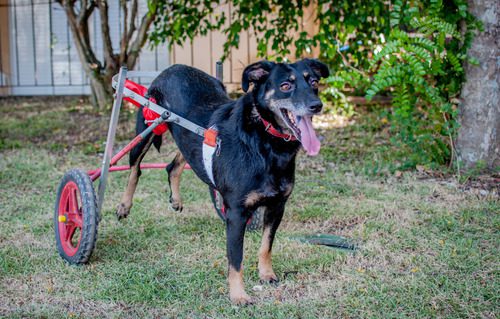Symptoms of Distemper in Dogs for Clifton Park Pet Owners
Distemper is a preventable viral disease in dogs, which most frequently affects young puppies. It can sometimes affect older unvaccinated dogs, but the newborn to six month age bracket is most at risk.

Dogs can acquire the virus from other domestic dogs, however they can also get it from wildlife- wild canids (coyotes, wolves, foxes), skunks, and even raccoons can transmit it.
It’s spread mostly by contaminated surfaces or direct exposure to an infected animal’s cough or sneeze, just like respiratory viruses in people.
The virus can continue to shed for months after a dog or wild animal has had it, so even animals without symptoms can affect unprotected animals. It can even be transmitted from an infected mother to her puppies in the uterus.
What Does Distemper Virus Do to Dogs?
Symptoms range from respiratory, to gastrointestinal, to neurologic. The virus attacks all of these body systems, and symptoms may appear progressively, or all at once.
Infected puppies might first seem lethargic with runny eyes. This develops further into a runny nose, and a cough that could progress to a deadly pneumonia. Puppies will develop a fever as their body tries to combat the virus, and their appetite will decrease dramatically. When it begins to affect the gastrointestinal tract, vomiting and diarrhea will start.
The most severe symptoms, however, occur when the virus attacks the nervous system. While owners will likely see the above symptoms first, it won’t be long before they notice odd behavior.
Affected puppies will often start circling and have a head tilt- it will generally be in the same direction, constantly, and it may seem obsessive.
Unfortunately it isn’t voluntary- when the virus replicates in the brain, it affects neurons, damages tissue, and causes lesions that result in permanent brain damage. This can lead to uncontrollable twitching, tremors, seizures, blindness, and sometimes even paralysis.
Chances of Recovery from Distemper Are Low
The worst thing about this preventable disease is that it is fatal more often than not. The lucky dog that does recover will probably have neurologic abnormalities for the rest of their life. These survivors will also have thick/hard foot pads. Because of this distemper is also known as “hard pad disease.”
How Do You Know Your Dog Has Distemper?
Veterinarians can often diagnose distemper virus based entirely on symptoms, without running any specific tests. Though there are tests available through specialty laboratories that can officially confirm the diagnosis.
When the puppy or dog is diagnosed, they are often immediately transferred into an isolation suite, where they can be cared for separately from other animals in the hospital. This is partly to keep them from spreading the virus to susceptible pets, but it is mostly to protect them against exposure to other things that could make them even more sick.
When this virus attacks, their immune system is already seriously challenged, meaning they are prone to pick up other infections too.
Treatment of Distemper for Dogs
These puppies get dehydrated quickly- they’re not eating or drinking, and they are vomiting and having diarrhea frequently. They might have trouble swallowing because the virus has affected their nervous system. And they just feel terrible.
Veterinarians will often start them on IV fluids right away, along with medications to stop the vomiting and diarrhea. If they show neurologic signs like twitching, tremors, or seizures, anti-seizure medications may be required.
Pain medications can manage their discomfort, and antibiotics can help prevent a secondary infection (an infection that only happens because the puppy is already sick and prone to acquiring other issues).
Beyond that, treatment involves intensive nursing care from veterinary technicians and support staff. This includes hand feeding, sponge baths, changing bedding, giving medications, and keeping noses and eyes wiped off. Sometimes a nebulizer or oxygen therapy may be used for puppies who have developed pneumonia.
An Ounce of Prevention is Worth a Pound of Cure
Prevention of distemper is as simple as vaccination. This isn’t just important for puppies. Keeping adults vaccinated is important too- if there’s too long of a lapse between annual vaccines, the dog is at risk. And as it said above, a mother can transmit the virus to her puppies in the uterus, well before you can do anything to protect the puppies themselves.
The distemper vaccine is typically given in combination with others- such as adenovirus or hepatitis (which affects the liver), coronavirus (which causes gastrointestinal signs, and is in the same family as COVID-19 but it doesn’t affect people), parvovirus (which affects the intestines), and sometimes parainfluenza (which is different from influenza, but still affects the respiratory tract.)
The distemper combination vaccine starts as a series, ideally given to puppies starting between six to eight weeks of age, and repeated every three to four weeks until the puppy is at least four months old. Adults generally get the vaccine every one to three years, though if they didn’t have the series as a puppy, or it’s been a long time since the last distemper was given, many vets will require an initial vaccine followed by 1 booster, then a vaccine a year later, before they will allow it to stretch out to 3 years.
Appropriate vaccination is absolutely vital to protecting dogs from distemper virus. It is completely preventable, expensive to try treating, and often fatal. Talk to your veterinarian about the distemper vaccine today- if your dog is up to date, they can let you know what schedule you should maintain. If your dog isn’t up to date, they can help you set up a vaccination protocol that will get your pet back on track!
Recent Posts
Dog Acupuncture: Does It Really Work?
Dog Acupuncture: Does It Really Work? Dog acupuncture might sound unconventional to some, but this holistic treatment…
Dog CCL Surgery: Cost & Recovery
Dog CCL Surgery: Cost & Recovery When your dog starts limping or suddenly refuses to put weight…
Degenerative Myelopathy in Dogs
Degenerative Myelopathy in Dogs Degenerative myelopathy in dogs is a progressive spinal cord disease that often takes…
About Us
Originally opened as Animal Care Hospital by Dr. Mark Johnston in 1989, the hospital became Cornerstone Veterinary Hospital in 2015 when it was purchased by Drs. Alan and Lisa Knott. The name 'Cornerstone' holds a special place in their hearts, representing not only their Christian faith but also their commitment to being the cornerstone of the community in which they practice. As a family-owned and operated practice, every pet is treated as part of the family, ensuring they receive the highest standard of care. The team at Cornerstone Veterinary Hospital is dedicated to building lasting relationships with clients and their beloved pets, striving to be the cornerstone of the community in which they practice.



